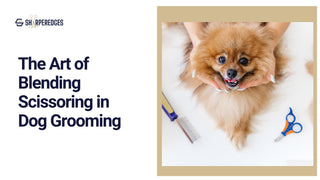Blending scissoring is a fundamental technique in dog grooming that ensures a smooth and polished finish between different lengths of fur. This technique is essential for creating a natural and seamless transition, particularly on breeds with varying coat densities.
Whether you are a novice groomer or a seasoned professional, mastering blending scissoring can significantly enhance the quality of your grooms, leaving clients and their furry companions satisfied.
Understanding Blending Scissoring
Blending scissoring involves using specialized scissors, often called blending shears, to merge different lengths of fur into a cohesive and smooth look. These scissors have teeth on one or both blades, allowing them to remove excess bulk without creating harsh lines.
This technique is especially useful in areas where the coat transitions from short to long, such as the neck, shoulders, and thighs. It’s also effective in softening the lines on the face and legs, providing a balanced appearance.
Steps to Perform Blending Scissoring Effectively
- Preparation: Begin by thoroughly brushing and detangling the dog's coat. This ensures that the fur is free of knots, making it easier to work with and preventing uneven cutting.
- Assessment: Analyze the dog's coat to identify areas that require blending. Look for sections where the fur changes length or density, and determine the level of blending needed to achieve a seamless look.
- Technique: Hold the blending scissors parallel to the coat and use a comb to lift small sections of fur. Gently close the scissors while moving them in a fluid motion along the coat. The key is to use a light hand and avoid applying too much pressure, which can result in uneven cuts.
- Direction: Follow the natural growth direction of the fur. This helps in maintaining the coat's integrity and prevents any unnatural appearance. For areas like the neck or legs, ensure you blend in the direction that aligns with the dog's posture and movement.
- Consistency: As you work, periodically step back to assess your progress. Consistency in blending is crucial for achieving a harmonious finish, so take the time to check that each section transitions smoothly into the next.
Ideal Coats and Breeds for Blending Scissoring
Blending scissoring is particularly beneficial for breeds with double coats or those with a mix of long and short fur. Breeds such as Golden Retrievers, Spaniels, and Terriers often require blending to maintain a natural flow between their top and undercoats.
Additionally, dogs with feathered fur on their legs or tails benefit from this technique to avoid abrupt transitions.
Tips for Groomers
For novice groomers, practice is essential. Start with less visible areas or on mannequins to build confidence. Use high-quality blending shears and maintain them regularly for sharpness and precision. Experienced groomers should focus on refining their technique, experimenting with different angles and pressures to achieve the best results.
The Benefits of Mastering Blending Scissoring
Proficiency in blending scissoring can elevate your grooming skills, allowing you to deliver professional and aesthetically pleasing results. It enhances the dog's appearance, providing a well-balanced and natural look that clients will appreciate. Moreover, mastering this technique can differentiate your services in a competitive market, attracting more clients and boosting your grooming business.
Check out these blenders from Sharperedges.
Blending scissoring is a vital skill in the grooming industry. By understanding its importance and practicing regularly, groomers can achieve seamless transitions and elevate their grooming standards, ensuring both dogs and their owners leave the salon happy.


